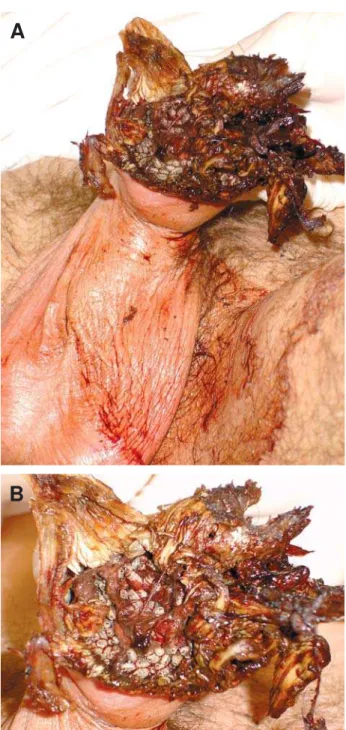521
Carcinoma of the Penis Associated to Myiasis Case Report
International Braz J Urol Vol. 33 (4): 521-522, July - August, 2007
Urgent Penectomy in a Patient Presenting with Epidermoid
Carcinoma of the Penis Associated to Myiasis
Antonio J. Tavares, Rodrigo Barros, Luciano A. Favorito
Section of Urology, Souza Aguiar Municipal Hospital, Rio de Janeiro, RJ, Brazil
ABSTRACT
The objective of this study is to describe the case of a patient presenting advanced epidermoid carcinoma of the penis associated to myiasis. A 41-year-old patient presenting with a necrotic lesion of the distal third of the penis infested with myiasis was attended in the emergency room of our hospital and was submitted to an urgent penectomy. This is the first case of penile cancer associated to myiasis described in the literature. This case reinforces the need for educative campaigns to reduce the incidence of this disease in developing countries.
Key words: penis; penile cancer; myiasis; amputation Int Braz J Urol. 2007; 33: 521-2
INTRODUCTION
Penile cancer is a rare neoplasia with low incidence in developed countries (0.1 - 0.9/100.000 in Europe and 0.7 - 0.9/100.000 in the United States). In developing countries, the incidence of this neoplasia is alarming with indexes that reach 2.9 - 6.8/100.000 in Brazil and 2 - 10.5/100.000 in India (1). Myiasis is defined as a disease caused by the infestation by larvae or maggots, of numerous species of flies (2). The occurrence of myiasis in the genitalia is rare. The objective of this article is to describe a case of myiasis in a patient presenting carcinoma epidermoid of the penis.
CASE REPORT
A 41 year-old patient came to the emergency room of our hospital presenting with dehydration, fever, paleness and claiming of strong pain in the genital
region. On physical examination, we noticed an extensive necrotic lesion affecting the distal third of the penis (Figure-1A). We have also observed the presence of gross keratinizations in the lesion and an intense infestation due to myiasis (Figure-1B). The patient was previously healthy and had been hospitalized 2 years before to be submitted to a postectomy in another hospital. At the time of postectomy, a suspicious lesion in the gland was biopsied; however, the patient abandoned the treatment without knowing the result of the biopsy.
522
Carcinoma of the Penis Associated to Myiasis
COMMENTS
Myiasis is the infestation of the organs or tissues of host animals by the larval stages of dipterous
flies, usually known as maggots or grubs. The fly larvae feed directly on the host’s necrotic or living tissue, or in ulcerated mucosa and cavities (2). The most common form in men is in the skin, where the species Dermatobia hominis is the most common. The severity of the condition depends on the location and the degree of tissue destruction (2).
Penile cancer is very common in Brazil and the main risk factors of this neoplasia is phimosis, local chronic irritation, lack of personal hygiene and HPV types 16 and 18, that are present in around 50% of the patients with penile cancer. Neonatal postectomy is a significant protection factor for the occurrence of penile cancer (3).
In the present case, we observed a typical example of a misinformed individual, with precarious hygiene habits, leading to the aggravation of a condition that could have a less aggressive treatment in the initial phase. This is the first case of myiasis in a penile carcinoma described in the literature and serves as a warning, reinforcing the need to implement educating campaigns on penile cancer in developing countries.
CONFLICT OF INTEREST
None declared.
REFERENCES
1. Solsona E, Algaba F, Horenblas S, Pizzocaro G, Windahl T; European Association of Urology: EAU Guidelines on Penile Cancer. Eur Urol. 2004; 46: 1-8.
2. Passos MR, Barreto NA, Varella RQ, Rodrigues GH, Lewis DA: Penile myiasis: a case report. Sex Transm Infect. 2004; 80: 183-4.
3. Schoen EJ, Oehrli M, Colby C, Machin G: The highly protective effect of newborn circumcision against invasive penile cancer. Pediatrics. 2000; 105: E36.
Figure 1 – Patient affected by carcinoma epidermoid of the penis associated to myiasis. A) Note the extension of the necrosis, affecting the distal third of the penis. B) Magnification highlighting the myiasis
that affected almost the totality of the necrosed area of the penis. Accepted after revision: November 24, 2006
Correspondence address:
Dr. Luciano Alves Favorito Rua Professor Gabizo 104/201 Rio de Janeiro, RJ, 20271-320, Brazil E-mail: favorito@uerj.br
